
*Suspension Upgrade*

![]()
News: The car's suspension has been radically changed (different springs, dampers, strut mounts, alignment, etc.) since October 2003. I have not had time to do a page on the new setup. Please check back later! Thanks.
Note: This is a large page with lots of text and lots of pictures. Please be patient while it loads. Text that's highlighted in yellow is just to remind me of areas that are incomplete.
This page is not meant to be a list of instructions. However, a good summary of installation procedures for similar upgrade items as mine are available at http://www.rose-hulman.edu/~smithm3/mods/PSS9/index.htm.
This page is divided into several sections:
1. Introduction
2. Overview of
Suspension Parts
3. Acknowledgements
4. Photo "Essay"
5. Suspension/Handling
Comments
The BMW E36 (3 series) has a chassis and suspension that are already quite well tuned for sharp handling and response. However, there were some areas that I found could benefit from improvement, which is why I decided to change certain parts of the suspension.
Some
complaints include:
1. Steady state understeer, especially in smaller radius corners
2. Transient response that was not quite quick enough
3. A little bit too much body roll for quick transitions
4. Slightly vague steering feel over sharp mid-corner bumps
Although 2 and 3 above would be improved upon by the simple lower and stiffer spring approach (as long as the car doesn't drop too low to mess up the roll axis entirely), I had to do some preliminary research to see what was causing the first complaint of steady state understeer. The E36 318is with manual transmission has about a 49%/51% front/rear weight distribution. Ron Katona kindly provided me with approximate motion ratios for the front and rear suspension and I was eventually able to do some measurements myself too. The motion ratio graphs are here. With some searching, I was able to determine the stock spring rates to be approximately 90 lb/in at the front and 300 lb/in at the rear. Without considering the anti-roll bars, these figures show that the car really should not be understeering much. Anti-roll bars are taken into consideration on the suspension analysis page.
However, a look at the tire wear characteristics when these cars are driven hard show a substantial amount of outer shoulder and even sidewall wear on the front tires. The McPherson strut design no doubt compromises the camber management ability of the front suspension. Thus I decided to pursue a method of increasing negative camber (both statically and dynamically).
The 4th complaint above wasn't a big issue, but since I was making changes to the suspension, I decided to address it too.
2.
Overview of Suspension Parts
The non-stock parts that I ended up using are listed in the table below, with a
brief description about each part. Not all of these were installed
simultaneously. Click
on the image thumbnails for larger pictures.
| Front suspension parts | Photo/Picture | Part number | Approximate cost* (US$) | Source | Description | Installation |
| Under chassis cross reinforcment (x-brace) |
 |
51 71 8 410 212 | $109 | Stephen at South BMW Motors | This part was developed by BMW M for its motorsport cars and for the E36 cabriolets and roadsters. It provides additional rigidity between the front subframe and the unibody, which results in less movement of the lower control arm under cornering. | Self-installed
in 03/00 |
| Electrodyne billet aluminum strut brace |
|
n/a | $150 | This brace reduces the relative movement between the top of the left and right strut towers and thus reduces the change in geometry during cornering. | Self-installed
in 08/00 |
|
| Solid rubber lower control arm bushings (from 96+ E36 M cars, p/n ) |
 |
31 12 9 069 035 (pair) | $42 (pair) | Rico Lee | The stock bushings have large voids to allow the rear of the L-shaped control arm to move in the cross-car direction. These solid bushings reduce the cross-car movement, thereby reducing the fore-aft movement of the ball joint (and the resultant change in caster). | Installed
by CG Motorsports in 08/01 |
| Offset upper strut mounts, L-R swapped (from 96+ E36 M cars) |
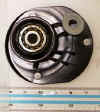  |
31
33 2 227 897 (left) 31 33 2 227 898 (right) |
$71 (each) | Rico Lee | These upper strut mounts from the 96 and later E36 M cars mount the top of the strut slightly outboard (reducing negative camber) and aft (increasing caster). When the left and right units are swapped, the caster is still increased, but the reduced negative camber becomes increased negative camber. It is worth noting that the M cars with this upper strut mount have a different steering knuckle/kingpin, so considering the change in camber and caster from this part alone is incomplete. This unit adds about 3 degrees of caster and an addition -1 degree of camber when this mount is swapped left to right. | Self-installed
in 10/01 |
| Strut tower reinforcement (from 3/96+ E36 M cars) |
 |
31 31 2 489 795 (for each side) | $6 (for each side) | Rico Lee | This reinforcement plate is only a couple of millimeters thick and reinforces the top of the strut tower to reduce metal fatigue. It was phased in on the E36 M cars in 1996 perhaps because BMW found that the increased caster (and thus changed load paths) was stressing the body. | Self-installed
in 10/01 |
| Wheel spacers (10mm) |
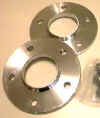 |
n/a | $100 (pair) | Ultimate Garage | These wheel spacers were necessary to accommodate the Bilstein PSS-9 suspension system with my 225/50ZR16 tires on 7x16 ET46 wheels. Depending on your tire/wheel/ride height combination, a 5mm or 7.5mm spacer may be sufficient. | Self-installed
in 10/01 |
| Longer wheel bolts |
 |
n/a | $3
(each) Ten needed |
Ultimate Garage | These bolts are necessary to provide sufficient thread engagement of the wheel bolts into hub assembly when using the wheel spacers. | Self-installed
in 10/01 |
|
Rear suspension parts |
Photo/Picture | Part number | Approximate cost* (US$) | Source | Description | Installation |
| E46 Cabriolet/M shock mounts |
  |
33 52 6 754 096 | $14 (each) | Rico Lee | The rear shock mounts are often the first failure point for the BMW E36; the movement from and the loads generated by the shock makes the rubber mounting disintegrate. These shock mounts used in the E46 cabriolets and M3 are the most durable ones available from BMW. These mounts have been replaced by the Ground Control mounts. | Self-installed
in 10/01 Removed in 03/03. |
| E36/7 (Z3) roadster shock tower reinforcement plates |
|
51 71 8 413 359 | $11 (each) | Rico Lee | These reinforcement plates are used in the E36/7 (Z3) roadsters. They are probably not necessary in an E36/2, but they add to the piece of mind, especially when using stiffer shocks. This was removed as part of the new shock tower brace substitutes this part. | Self-installed
in 10/01 Removed in 10/02 |
| Ground Control "street stability kit" spacers for trailing arm bushing |
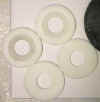 |
n/a | $60 (set of 4 spacers) | Ground Control Suspension | The toe control/locating member is the C-shaped trailing arm. At the front of this trailing arm is a rubber bushing mounted within a metal bracket. Due to shape of these two parts, the trailing arm can easily pivot about the bushing, allowing the rear toe to change under load and allowing the rear suspension to steer passively. These spacers fill in the voids between the bushing and the bracket to reduce the toe change. | Self-installed
in 10/01 |
| Fender washers |
 |
n/a | $2 | Hardware store | 5 fender washers stacked to give a height of about 8 mm were inserted between the top of the shock and the bottom of the shock mounts to give increased shock rebound travel which was determined to be an issue over sharp crests and awkward driveway entrances where an inner rear wheel can spin as it became unloaded due to the lack of droop travel. The fender washers have been removed as the Ground Control rear shock mounts provided additional droop and rendered the washers unnecessary. |
Self-installed in 10/02 Removed in 03/03 |
| Shock tower brace |
|
n/a | $20 | eBay | I found an inexpensive rear shock tower brace on eBay. These typically go for 10 or 15 times the price, so I thought it was be a good deal. The quality was better than expected, although they did a bad job tapping the threads on one end. Also, the welding is somewhat poor. Higher strength steel is probably needed to truly reduce shock tower flex, but I think any reinforcement is helpful as my shocks are very firm, and I often hit the droop (and maybe even bump) stops (and maybe even the bump stops) without my knowing it. This rear shock tower brace was removed as the Ground Control rear shock mounts interfered with the brace's mounting bracket, but now that I have different brackets, this bar has been reinstalled. |
Self-installed in 10/02 Removed in 03/03 Re-installed in 03/03 |
| Ground Control rear shock mounts |
 |
n/a | $75 | Bimmerworld | The primary advantage of this mount, other than its stiffer urethane bushings that allow the shocks to perform better is that its mounting allows for removal of the shock without opening the trunk and removing the speakers and carpeting. Also, the bushings can be mounted step-in for reduced compliance (race mode) or step-out for increased compliance (street mode), which is how I'm using them. I started using them in hump-down orientation to increase my droop travel, but I'm not running them in hump-up as my droop issue has been fixed with longer shocks. | Self-installed in 03/03 |
|
Front and rear suspension parts |
Photo/Picture | Part number | Approximate cost* (US$) | Source | Description | Installation |
| Bilstein PSS-9 adjustable valving, adjustable height, coilover suspension system (struts, dampers and springs) |
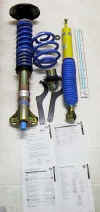 |
n/a | $1185 | Gary Krumian | This is a suspension kit that replaces the springs, struts and dampers of the car. It allows ride height/corner weight adjustment at all four wheels as well as damping that is externally adjustable in 9 discrete steps without having to removing/uninstalling any component. The damping adjustment affects both rebound and compression. The front main spring rate is 399 lb/in. The front help spring rate is 114 lb/in, and the rear spring rate is 428 lb/in. In comparison, the stock suspension's front spring rate is around 100 lb/in, and the rear spring rate is in the 300 lb/in range. This kit passes gets German TÜV approval by preventing the springs to become loose under full droop. At the front, this is done by the helper spring. At the rear, suspension droop is limited by the damper. I chose this kit because it offered linear spring rates (so that hte overall balance wouldn't change significantly with height) and because of the externally adjustable damping. Furthermore, it uses standard race diameter springs at the front, so I could swap them easily for other rates if necessary. Details are describe below, in the Photo "Essay" section. Here is a link to the official Bilstein page. | Self-installed
in 10/01 |
*This is the price that I paid, excluding shipping and taxes through various discount sources.
So many people have helped me out, and I think I should thank them here. I'll probably leave out a few names by accident, but I'll do my best anyway.
Installation:
Earl Webster
Herman Chan (special thanks for the use of his garage and tools)
Stan Demas
Tuning:
David Crawford
Dean Schindell
Hunter Johnson
Ian Frechette
Kevin at Custom Alignment
Ron Katona
Scott Badenoch
This section is not meant to be directions for installation. Instead, it is a discussion based on the photographs taken before, during and after the installation process. Click on the image thumbnails for larger pictures. Please send me email if you have questions about installation, and I will try to be of assistance.
We start with the front suspension...
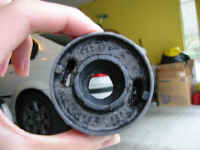 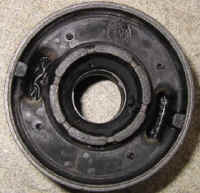 |
Before we get to the Bilstein kit, here are two views of the M centered lower control arm bushing as described in 2. Overview of Suspension Parts. |
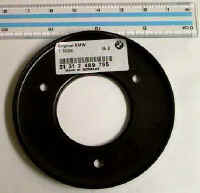 |
Here is the upper strut mount reinforcement as described in 2. Overview of Suspension Parts. |
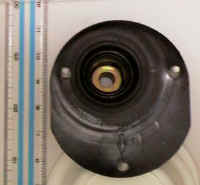 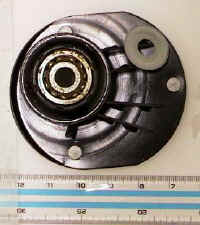 |
Two pictures of the upper strut mount are shown here. The top one is the top view (what you'd see if you were standing in front of the car and looking down, but you wouldn't actually see this because it's under the sheet metal)! The bottom one is the bottom view. For some reason, I placed a washer there when I took the photo. More information was given in 2. Overview of Suspension Parts. |
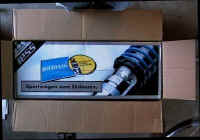 |
Here is how the Bilstein PSS-9 kit came. Each spring/strut/shock is individually bubble wrapped with a bag of hardware for each corner. |
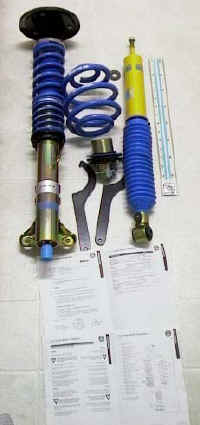 |
Pictured here is about half of the kit. Only one of each front and one of each rear component is shown. Note that the black strut tower reinforcement and mount are not part of the kit, and neither is the ruler =) The kit comes with documention that is surprisingly good in some areas and surprisingly poor in others. I'll write a bit more about this later, somewhere... |
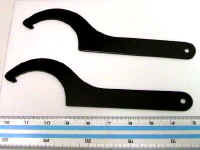 |
These are the wrenches used to adjust the height of the front suspension. Two are needed to tighten and loosen the locking perch against the main perch. |
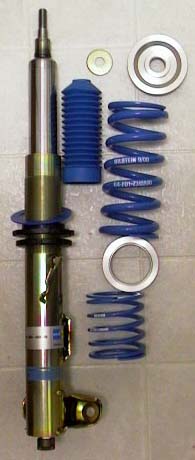 |
Here is one front suspension set. The dust shield/bellow has been removed to show the top of the strut. A washer is included to protect the upper strut mount and lies between the top spring hat and the strut mount. An intermediate spacer separates the main and helper springs. A plastic liner lies between the helper spring and the lower spring perch. Note the brown dial at the bottom of the strut. This is the adjustment knob for the damper valving. |
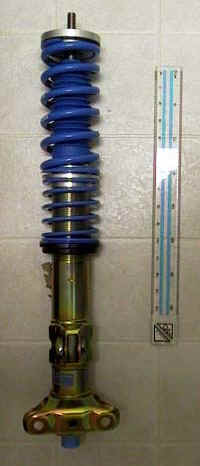  |
The left picture shows an assembled but untightened strut unit with the attachment for the steering knuckle facing you (i.e., inboard view). The picture on the right shows the outboard view. Also notice that there are blue caps for the damper adjustment dials. |
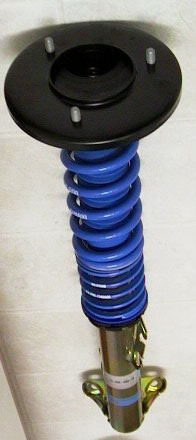 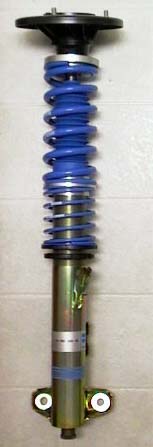 |
Here the upper strut mount and strut tower reinforcement plate have been placed onto the strut. |
 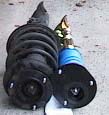 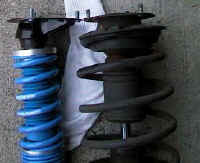 |
We can compare the original strut and the Bilstein strut. I don't remember the Bilstein strut being shorter than the stock one, but it certainly looks that way. |
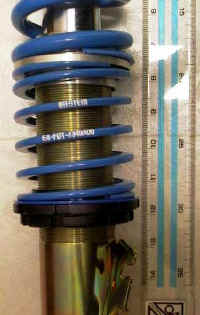 |
Here
is a close-up of the 114 lb/in helper spring (E4-FD1-Z349A00) with flat
wire making up about 3 working coils. Spring rate: 114 lb/in Free length: 85 mm Outer diameter: 80 mm Inner diameter: 63 mm Wire diameter: 11 mm 5 working coils The intermediate spacer between the two springs is about 5 mm thick. |
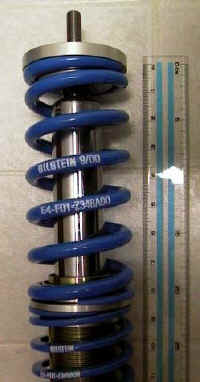 |
The
main spring (E4-FD1-Z34A00) has a 399 lb/in rate. Spring rate: 399 lb/in Free length: 179 mm Outer diameter: 83.5 mm Inner diameter: 72 mm |
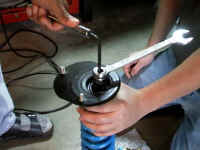 |
Assembling and disassembling a strut can be difficult and annoying. Usually, a spring compressor is necessary to be able to put on the securing nut. However, it was not necessary because the spring preload was not very high. Still, another "problem" is that the strut's shaft would spin when the nut is tightened. An impact driver is often used, but this may damage adjustable shocks. A common method is to put a hex key into the hex cutout of the top of the shaft to hold it still (as is shown in the picture) and to use a thin-walled socket to tighten the nut. Special sockets with machined/flattened ends can be purchased, allowing the use of wrenches to turn the socket. If you're stuck with a regular socket, you can use vise-grips to turn the nut. In my particular case, a 3/4" spark plug socket fit over the nut almost perfectly, and since a spark plug socket already has flattened surfaces, it was easy to use a wrench to turn the socket and nut. However, on our first drive, we noticed a clunking sound which was from the strut nut being very loose and the top spring hat moving up and down! We were sure we tightened and torqued the nut, so we think that the spring or some other part must have been cocked while we were tightening... |
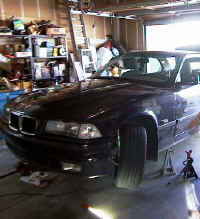 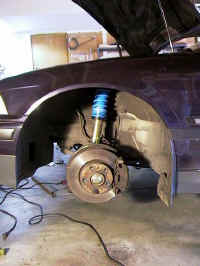 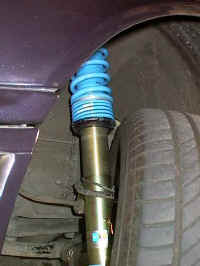 |
These are pictures of the suspension with the Bilstein kit installed. |
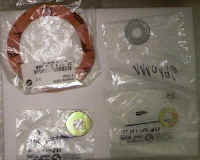 |
Here is some miscellaneous hardware that I purchased in case I needed to replace some of these. |
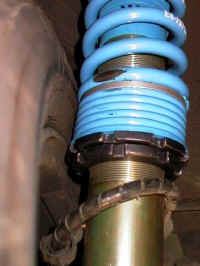 |
We knew that the clearance between the tire and springs were close, but we didn't know it would be this bad. I have 225/50/16 tires on 7x16 ET46 wheels. I also tried 205/60/15 tires on 7x15 ET47 wheels, but it didn't help. So I had to get a pair of 185/65/15 tires ET on steel wheels while I waited for my wheel spacers. |
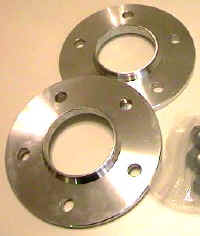 |
These are 10 mm wheel spacers as described in 2. Overview of Suspension Parts to address the clearance problem. |
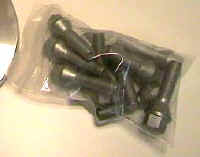 |
These longer wheel bolts are necessary to provide sufficient thread engagement into the hub due to the use of the wheel spacers. |
Let's go on to the rear suspension...
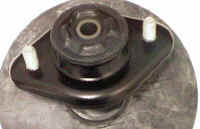 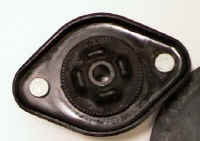 |
Again, we start with the non-Bilstein parts. These are the upper damper mounts for the rear dampers. The top picture is a top view, and the bottom picture is a bottom view. |
|
|
Here is a shock tower reinforcement plate as described in 2. Overview of Suspension Parts. |
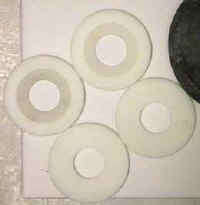 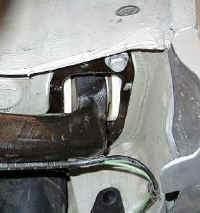 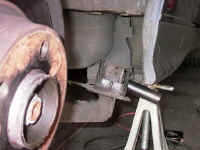 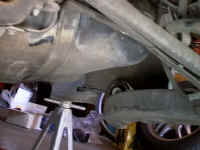 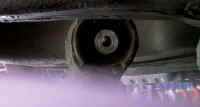 |
The Ground Control Street Stability Kit trailing arm bushing spacers are hard to explain, which is why there are so many pictures, even though I described them in 2. Overview of Suspension Parts already! The top one are the plastic spacers for the trailing arm bushing. Two are needed for each side of the car. The second picture is not one that I took, but it's from the Ground Control website. The whitish part between the black steel parts are the plastic spacers. The third picture is a view from the rear right corner of the car, looking forward. Here the trailing arm has been removed from the body and is dangling. The spacers have not been installed yet. The fourth picture shows the same trailing arm but from under the rear center of the car. The bottom picture shows the trailing arm bushing closer. |
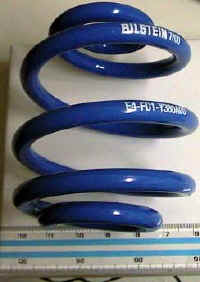 |
The rear spring (E4-FD1-Y380A00) is about 170 mm tall with 15 mm wire diameter and 3 working coils. The rate is listed at 428 lb/in, although given its shape, it is probably slightly progressive. |
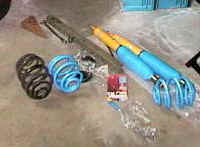 |
Here you can see the difference in length between the stock and Bilstein springs. |
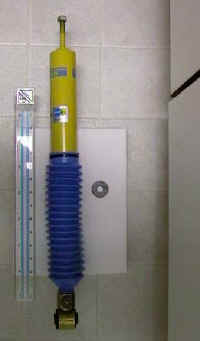 |
Here is a rear damper. The picture is not upside-down! The damper body is at the top and the blue bellow dust shield covers the shaft which is below the body. |
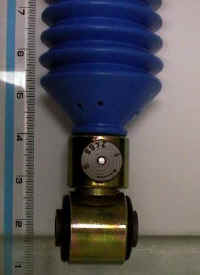 |
Here you see the damper valving adjustment dial for the rear damper. Strangely, you read the numbers at the top of the dial, so the number is upside-down. So right now, the damper is at setting 3 (one is firmest). |
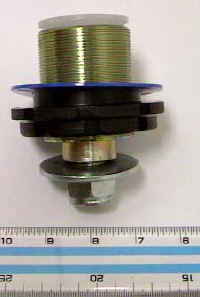 |
The rear ride height is made adjustable by removing the lower spring pad and replacing it with this threaded barrel on which the spring seats. Because this assembly drops into the upper control arm, the spring must be removed to turn the spring perches to adjust the height. The bottom nut is huge (24 mm) as you can tell by the ruler and is a pain to put on because it has a nylon lock that requires a lot of torque to overcome. Things are complicated even more because the nut almost touches the halfshaft! |
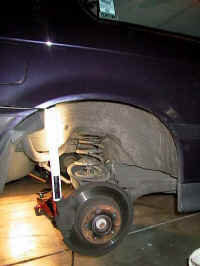 |
Here is the rear right corner of the car with the damper removed and the stock spring still in place. That white thing where the damper should be is a fluorescent lamp! |
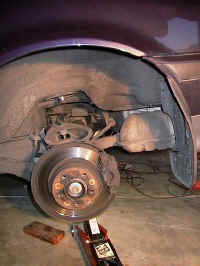 |
Now the spring has been removed too (except that this picture shows the rear left corner). |
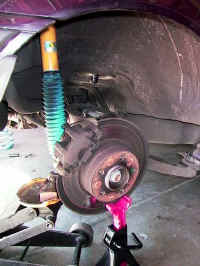 |
Back at the rear right corner with the Bilstein damper installed. There's no spring yet though. |
Now we have some photos of the car before and after the Bilstein kit. Note that the car definitely rides higher in the front now than what is shown in the "after" photos. I haven't made measurements or taken photos for the most current setup (i.e., after the corner weight adjustment). The rear is probably a little lower than what is shown in "after" due to the corner weighting and the use of a thinner upper spring pad. Ride heights are "standard" measurements, i.e., from the bottom of the fender lip to the lower edge of the wheel. Update info.
5. Suspension/Handling Comments
Comments on this page are mostly taken from my email records and then edited to fit on this page.
March, 2000
X-brace installed
The x-brace makes a large difference under high cornering loads. At a familiar downhill right-hander, I feel less understeer and more predictability from the front tires. It feels like the front camber is better managed and the tires roll onto their shoulders less. Now the tires hold on better and then wash away when they are way beyond the limit, whereas they began to wash away earlier before. So, in a way, the x-brace may be making the front tires hold better, but the transition to terminal understeer is a little more abrupt in my case.
August, 2000
Strut brace installed
I installed the strut brace and then went to a driving school clinic and drove the car hard, which I haven't done recently without the strut brace, so I can't really compare the differences. I need to go to a track again and take repeated runs with and without the brace to tell the difference, if any.
August 30, 2001
M front lower control arm bushings installed
... it's the bushings that really surprised me, so I'll talk about those first. I changed from my original bushings to the 96+ M bushings. These are not offset (as the 96+ control arms have a different arc to simulate the offset and move the lower ball joint forward) but are solid. Actually, they're not a true donut either. At the places left and right of the control arm finger, where there used to be voids in the bushing, this M bushing has reduced thickness rubber there, presumably to allow just a little bit of compliance.
These bushings make differences beyond what I had imagined. Before I say what, I should mention that my old bushings, although they looked OK from under the car, were worn according to CG Motorsports. One of them cracked when Rudy tried to rotate the bushing without much force. I had felt that something was loose up front (and posted about this before) and eventually attributed this looseness/vibration to either the bushings or the vertical compliance in the outer ball joints. I'm convinced now that the majority came from the bushings.
What's amazing about these M bushings (compared to my old worn non-solid ones) is that the car is now much *less* harsh. Whereas the old bushings made me feel a lot of the road texture, it almost seemed like they "talked too much nonsense." There would be some vibration after bumps which made me think something was loose. The differences are felt most over sharp bumps like lane reflectors, going onto or off of a slight parking garage ramp, and also going up and down these ramps that have horizontal slits in them. My steering used to vibrate as I went down these ramps, and now it is very stable. My first impression was that I had lost some tire pressure up front, but I don't think that's the case because the cornering behavior is about the same. I'll check pressures in the morning. There is just seemingly much less harshness. Over speed bumps, it almost feels like my front spring rates or shock compression rates have gone down. That was a big surprise. Perhaps my old bushings were just deflecting way too much over these bumps, or they had a lot of friction in them to cause the harshness. The most unexpected improvement was actually in the behavior of the rear of the car. I could not believe it, but those sunken manholes and bumps that used to make the rear end twitch hardly upset the car anymore! I'm still surprised by this, so I purposely went over the roughest parts of the pavement I could find and over my familiar "upsetting" roads. I cannot give an explanation for this other than that the front of the car is now staying planted instead of being affected by the rear and instead of letting the rear end move too far out of place. I used to think that I may need various new bushings at the rear and that the static toe-in and camber thrust may have been upsetting the car on single wheel dips, but that concern is much reduced now. I find the car far more confident on mid-corner bumps, almost like the E46 courtesy car I had about a year ago and much more like the car when it was, when I was confident going over these bumps. I'm just surprised that the one pair of good, new bushings will do so much. I now have to recommend this bushing change to anyone who's going with a stiffer suspension setup or heavy/large wheels. Without the good control of bushings, I think the ride will be a lot harsher and a lot less precise. No wonder BMW put these on the M3. I wonder why they didn't go on the regular E36 as I don't think they add any harshness at all. I will probably increase the rear tire pressures now that the rear doesn't feel as skitterish as before.
October 7, 2001
Bilstein PSS-9 installed
The ride is *amazingly* supple. Herman said that it's less harsh in a way than his car which uses regular springs and Bilstein HDs (which really don't work well on his car). Because I had the 185/65R15s up front with stiff springs, I decided to pump them up to 37 psi. Still, the front has significant tire roll, so I didn't push the car hard. The shock setting is now at full soft, which is pretty much where the fixed valving version of this coilover setup (Bilstein PSS) is set at. Over small bumps, this setup is barely harsher than my car with the sport suspension. Over bigger bumps and dips, you feel the motion of the vehicle more. There is a little bit of body pitching over certain combinations, but it is not severe. On the highway, the car moves a little more over some bumps but also settles faster over others. I seem to feel the road texture more through the form "noise" through the floorpan (as felt through my feet). But this may be the front tires doing it; these Bridgestones are louder than my regular tires. Also, the M upper strut mount has less rubber isolation. I took my friends out for dinner later, and they couldn't really feel the difference. However, on my way home, I noticed that over sharp crests, both ends would lose grip momentarily, probably due to the higher rebound damping. I also triggered the ABS very slightly even though I wasn't breaking that hard over a bump. Again, this might be the front tires. I didn't do hard cornering because the "wrong" front tires, but I can tell that the reaction is much faster and firmer. The car appears to roll, but I think this is due mostly to the front soft sidewall tires and maybe the increased caster which causes the diagonal weight transfer.
Basically gone is the body pitching under acceleration (well, my car can't accelerate that quickly anyway) and braking. But it's still not as fast reacting as Ron Katona's M3 with 500/550 lb springs. (These are 400 lb up front and 425 lb at the rear, although that's hard to believe from the ride). It might have to do with the tires. I think the alignment has something to do with it. The steering wheel is slightly off-center now, although it doesn't pull in any direction. I might have picked up 1/16" or so of toe-out on the way "down" at the front (just a guess).
When I get my tires put on with spacers, I will try out full stiff (and mid-stiff) to see what range there is. The current setup (full soft) is more than acceptable for every day use. The good thing is that I can adjust the shock valving via dial at the bottom of the strut/shock easily. I now see the light in highly digressive shock valving!
Mid-October, 2001
The original tires and wheels are now back on the front. The car responds more quickly and road input is magnified. There is an annoying issue where the car would turn-in, and, a split-second later, would turn-in tighter. Perhaps the rear shock rebound valving is not as stiff as the front.
I tried full stiff, and the car just skips and hops over imperfect road surfaces. This setting is not confidence-inspiring for the street. The car also reacts more quickly than I'd like to throttle inputs. I hear the tires make some whirring noise even under low lateral load.
Mid-October, 2001
I pumped up the tire pressures because the tires feel like they're working very hard (I feel the tire's slip angles changing noticeably).
Mid-October, 2001
Ground Control Street Stability Kit (trailing arm bushing spacers) installed
The Ground Control Street Stability Kit (trailing arm bushing spacers) is installed. That helps out with the two-stage turn-in greatly. I have a feeling that the two-stageness was partly due to the rear toe shifting under load. I turned up the rear shocks to mid-stiffness, but the change is barely noticeable. I need to go to a consistent surface to test things out.
November 2, 2001
Alignment and corner weighting
Alignment specs are here. Cornerweight specs are here.
I got my cornerweighting and alignment done today. It took almost 3.5 hours. Custom Alignment is very good. They take care of the car, do the ballasting, put covers on your floor mats, seats, etc. They removed the front ARB end links, although the rear was hard to do since it was within the control arm, and the guy didn't think it was necessary since the links were not adjustable in length. I had about 5/8 tank of fuel and my spare still in, which is how I'll be driving most of the time. Also, I assume the load with the tire doesn't change the corner balancing much. Anyway, I started out with a 48.5/51.5 F/R distribution, a 50.6/49.4 L/R distribution and a 49.0/51.0 cross (RF+LR) distribution. So it wasn't far off to start with. Consistent with my measurements, the left side of the car was a little low. When that was fixed, it moved the cross distribution a bit off, so the tech had to go through several rounds of adjustment. In the end, I ended up with 48.3/51.7 F/R distribution, 50.6/49.4 L/R distribution and 50.0/50.0 cross distribution.
The alignment went pretty smoothly too, although the front tie rods needed some heat. Apparently I was running 0.32" of toe OUT, probably due to the lowering (toe out with bump). Also, the right was toed out much more than the left, which is probably why my steering centered slightly left off center. I had asked them to put the toe at about 0.07", but had I known that I was already at that much toe out, I would have asked for close to zero toe since it really didn't bother me with that much toe out. The guy ended up setting the toe to 0.12" toe in. I'm not sure why he didn't go closer to my spec of 0.07", but this is within the BMW spec anyway. Camber started off at -2.00 and -2.10, and caster was dead even at +5.9. Front camber was evened out at -2.00; he was able to adjust it at the lower end of the strut. Caster was evened out to +6.20 at each end. The steering axis (kingpin) lateral inclination are 17.10 and 17.20, so that might partly explain why clearances were a little tighter on the left side. Setback is 0, so the front wheels are even on the fore/aft axis. The tech said that my car wandered/tramlined a little, but the high caster helps a lot. If I had been running that toe out with regular caster, it probably would have been quite difficult. In any case, I didn't feel any problems with tramlining (I guess I'm used to it), which is why I wouldn't have minded some toe-out.
The rear thrust angle and setback are zero. Camber started out at -3.00 and -2.80! The best that he could do was bring them down to -1.80, which is pretty much where I asked him to bring it. BMW specs about -2.00 for my car and -1.75 for the M3. With the stiffer setup and slight push, I didn't think I needed any more rear negative camber. The toe started out at +0.20", and the guy brought it down to about 0.12", which is one extreme of the recommended range.
So even though I got some toe-in on the front (which slows the turn-in slightly), the decreased toe-out at the rear makes the car corner a little more effortlessly. But I need to drive more to find out. I might consider trying less toe-in in the future, but I want to go on the freeway first to make sure the car is not overly sensitive at high speed.
November 6, 2001
Steering
I've noticed some changes in steering feel and response, but I haven't addressed them yet. The most noticeable change for me was a slightly stronger self-centering effect. In the past, I would usually have to unwind/center the last 1/8 turn or so of the steering wheel when exiting a 90 degree corner. Now, that's probably down to less than 1/16 of a turn. Also, the steering effort is marginally heavier at all speeds, and there's a stronger on-center feel. When turning the steering wheel while stopped, the corner jacking and diagonal weight transfer effect is very obvious. The car seems to shift slightly laterally, while the outside front corner drops in height.
The steering effort still builds as the lateral acceleration builds, but it doesn't fall away as much nor does it become numb as the limit of the front tires are reached. I haven't really reached the limit yet, but I can see the car running wider, whereas before I'd usually feel it before I see it. I'm not sure if this is good or bad. With the camber and caster setting, I seem to be making better use out of the front tires, but I am not getting the feel that came from a loss of pneumatic trail.
I brought my rear shock valving to mid-range again, and the car is definitely quite neutral, especially if I trail brake into a corner.
November 24, 2001
Wet behavior
The car amazes me in the wet. I can't break it loose; I really have to try hard. With a stiffer suspension, higher tire pressures and more aggressive camber settings, I thought the car would be worse in the wet. But it isn't. Braking is about the same but acceleration and cornering have much higher limits in the wet. Are the roads in the S.F. Bay Area made of different material or something? (The last time I was driving hard in the wet was in Vancouver.) I think part of it might have to do with the digress shock valving. Over manhole covers, railway tracks and horizontal strips, the rear wheels used to slip, making the car "bob" a little before regaining traction. That bobbing is pretty much gone now, and the car just moves on forward. It seems like it is not affected by these small bumps as much as before. In the corners, I keep pushing it a little harder thinking that it would either understeer, or, if the front held on sufficiently, the rear might get loose, but neither happened.
December 14, 2001
Lift throttle, rubbing
The car responds to lift-throttle more readily. It doesn't get out of line (at the lateral G's I was going at), but it does respond, and very quickly. Should be fun at an autocross.
The rear of the front tires still rub the plastic fender liner when near full steering lock. I measured my wheelbase to be about 269 cm, which is 1 cm less than the stock 270 cm. I believe the increased caster (tilted strut) is responsible for this. Using the early E36 M3's offset lower control arm bushings or the later E36 M3's redesigned lower control arms should solve this.
January 6, 2002
Rear camber shifts
When I got my alignment done, the guy marked the washer and lower control arm to show where the camber setting was (in case I wanted to adjust it and then adjust it back). I noticed today that the camber has shifted probably an eight of a turn.02
January 8, 2002
Summary of impressions-to-date
The suspension started as a 318is with sport suspension (increased spring and damper rates and anti-roll bar size) on 225/50ZR16 tires. I have upgraded some bushings and mounts, but the most significant changes, I think, is in the use of the Bilstein PSS-9 coilover system and custom alignment (possibly partly because of different front strut mounts). More information on the parts is available from my website linked at the bottom. I chose the PSS-9 because it used standard diameter, linear springs front and rear and also because of the externally adjustable valving (and because of a discount).
I am overall impressed with the improvement and am pleasantly surprised by the minimal increase in high frequency harshness despite the increased stiffness and firmness (made possibly probably with very digressive shocks).
I have not driven the car with this setup yet on a "course" but have found some "imperfect" traits that I'd like to discuss with you.
First, about the spring rates. This setup has 400 lb/in springs at the front and 425 lb/in at the rear. The stock is somewhere around 100 lb/in and mid-200s lb/in
or around 300 lb/in. My friend's attempt to determine the motion ratio (so that we can determine the wheel rates) didn't give consistent results, so I can only provide the spring rates here. As you can see, the setup stiffens the front much more so than the rear. Theoretically, this would cause understeer. However, I have heard of others increasing the spring rates in this way and have not felt much understeer. My guess is that the stiffer rates allow the front suspension to manage camber much better. Also, I am running -2 and -1.8 degrees of camber f/r, compared to the stock values of about -0.5/-2. Caster is at about 6 degrees, up from 3 or so. I am running a little less toe-in than recommended, but still no toe out statically.
Perhaps the biggest "concern" that I have is that the car tends to pitch a bit in the corners. It's not that noticeable at low Gs but becomes quite pronounced at, say, 0.4Gs and above. My seat is near the center of the wheelbase (and the CG), and I think most of the movement is coming from the rear end. It never seems to go wild, but it's definitely not something I would call "well settled." The front is set for softest damping. I increased the rear damping (mainly affecting low speed rebound) to about mid-range, and I think it's better, but the difference is not huge. I am wondering if the changed front/rear spring rate ratio has to do with this. I know most stiffly sprung cars tend to pitch in general, but I am wondering if I can do something about this. The car also pitches slightly on the highways where there are changes in concrete patch height, but it's not very serious. The pitching is most obvious at high Gs because bouncing up and down tends to make the rear walk across mid-corner bumps. But in a way I like it because I can gauge the rear tire's performance whereas the old setup used to hold and then snap out more suddenly.
Another issue is the steering feel. I enjoy the increased caster for its greater straight line stability. However, I can't seem to gauge the front's slip angles as well. I've read that increased caster can make the mechanical trail dominate over the tire's pneumatic trail, so the usual numbing of the steering as the tire saturates doesn't feed back as well when a high caster is used. I also wonder if the high spring rates and high caster is unloading the inside rear and outside front too much. Due to my car's low torque, I have not had a problem with wheelspin yet. Also, this is the caster used on the M3s, so I think it's probably not excessive. I've also needed to put 10 mm spacers at the front to clear the PSS-9s, so maybe that has something to do with it. I read your point about using anti-roll bars for diagonal weight transfer. I guess a stiffer front bar would help put more load back onto the inside rear, but I don't think I need the increased roll stiffness. A respected friend of mine in the automotive industry has suggested disconnecting the rear anti-roll bar after I shared my concern about the rear bouncing around, and this would also put more weight back onto the inside rear, but I'm afraid it might cause the car to understeer too much or add more roll. An autocross friend of mine said that it sounds like there may be too much compression damping in the shocks, which I cannot really adjust. I guess that's possible since this setup was probably designed for large wheels (high unsprung weight).
Another thing is that the current ride height is not very low, probably no more than 3/4" lower than my original setup. I wanted to preserve the original rake because I had thought that most aftermarket springs lower the front more simply for the visual effect, and I wanted to keep the roll axis at about the same angle. I wonder if this is a mistake now that my research shows that BMW, on their sport suspension and M cars, also tend to lower the front more than the rear. Perhaps this is making use of the McPherson strut's roll center sensitivity. That is, this lowering of the front allows the front roll center to drop lower and reduce understeer. Or, maybe it's to tackle something that happens dynamically. Because my rates are significantly higher than the stock suspension, I may have to address things differently because I don't undergo nearly as much movement/roll overall.
January 8, 2002
Lack of droop travel?
As you might remember, we found out during alignment that my rear shocks don't allow enough droop to reach in to get my shocks. My springs are about 6.7" long. Unless the lower spring perch is at a very different height, I would think that my shocks probably have less droop travel than yours.
I determined today that I only have about 1.75" of droop travel from my static position. This is with both wheels off the ground. So, in cornering, the inside wheel might lift off before drooping even this far. I wonder if this is of concern; perhaps the suspension is designed for starting at a lower static height.
I lowered the shock damping back to full soft today to see if that cures any of the problems I've been having. In one turn, it seemed to worsen things, but it seemed to help in another. The car does ride more smoothly though.
Although I doubt it, I wonder if the inside rear wheel is being lifted easily due to the lack of droop travel. On acceleration out of corners, I think some of the pitching is coming from a non-constant forward acceleration. I don't think I'm spinning a wheel, but I could be losing a little traction from the inside rear becoming unweighted. Theoretically, this seems unlikely, but I'm wondering why the oscillation is worse under acceleration since I'm not accelerating that hard. The car seems to like the corner better if I'm coasting or braking through the bumps.
January 8, 2002
It seems that the rear end oscillation problem is worse when I'm also trying to accelerate and that it's reacting too quickly to bumps. I really don't think it's the case of my overworking the rear too much since the rear rates have not gone up much. I read that "walking over bumps" can be caused by too much compression damping, so I lowered my damping from mid-range to soft, but that didn't seem to help in the few turns that I took today. The adjustment does affect rebound more than compression, so I know I'm not going to solve it entirely this way. But it does affect compression somewhat. I'll try it out more. I really like how the front behaves (other than a reduced feedback close to the limit), but the rear is confusing me.
I determined today that I have about 1.75" of droop travel from my static height in the rear, but this will reduce in a corner since the anti-roll bar will couple the two sides. Is this droop travel typically sufficient? I'm wondering if the inside wheel might be lifting or losing traction under acceleration due to there not being enough shock extension.
I know I really should test this car on a skidpad to understand its steady-state behavior first, but I'm wondering if my comments here ring any bells. Anyway, more information is below.
January 8, 2002
I wonder why my shocks have less droop travel. Perhaps it's to help out the E36's problem of lifting the front inside wheel, but I doubt it. Yes, the pitching I'm describing feels exactly like the outside front loading up and the rear inside unloading. The thing is, I'm not really understeering. It just bounces. I don't know why it oscillates. What I can do is stiffen up the rear to full max and drive for a while. And then reverse it: max on the front and softest on the back. I hope that way I can at least know which way I should go. What confuses me is that the front is the very stiff end, and yet it feels like it's tracking fine. Perhaps it's simply my rear bushings wearing out? The feel is quite good if I don't apply power, I think. On a familiar corner under power, I hear tires chirping if I go in too hard. It never really makes the car uncontrollable despite the weight shift though. It's just unnatural feeling. But at higher loads, it'd probably get difficult. I wonder if the increased caster has something to do with it. But then again, you're running a lot of caster too.
I looked under the car again today. The camber markings were on the arm and the washer, which makes sense. So it seems that the nut could have let loose a little and the washer rotated.
January 9, 2002
Info from Bilstein
I just got off the phone with Lou from Bilstein. He is unaware of clearance issues with the front strut and tire but will get back to me. As for the limited rear droop, it is done so that the spring does not become unloaded and also because any more droop would cause the nut that holds the spring perch to become in contact with the halfshaft. They are redesigning it to put the nut on the top instead of the bottom of the control arm. He's going to throw a rear shock onto the dyno to see what the valving is like. He says that, despite the different gaps between the different numerical settings, the numbers adjust things fairly evenly. That is, going from 1-2 is about the same difference as from 3-4. He said that the adjustment doesn't change the size of an orifice as it is done with other systems but that it covers and uncovers bypass ports. He hasn't gotten other complaints of my oscillation problem, but he did say to try something stiffer to see what happens. Apparently, the adjustment does adjust compression in addition to damping, which is consistent with the fact that the car becomes much harder to push down when the setting is firmer. All the tuning was done in Europe, and many of the test cars have other aftermarket equipment. However, a stock car was also used in testing. They drove an E36 M3 with the setup recently and didn't notice any problems.
January 10, 2002
Info from Bilstein:
Lou dynoed the rear shocks. The adjustment affects both rebound and damping, roughly by the same percentage. It starts out quite stiff already, like a starting point for autocross. It then goes to race stiffness at full hard. He also mentioned that the compression valving is quite stiff in general.
Rear rebound set to full stiff:
I feel the road more. It's hard to tell exactly what I'm hitting since it's behind me (I think we're more sensitive to movement in the front suspension), but the car is definitely moving around more in response to the smaller bumps. In general, there is more movement, and the movements are faster, but the suspension may be undergoing less travel.
In the bumpy corners, the result is about the same. I feel the suspension moving faster and responding more so than I'd like, but there is less total movement, which seems to keep the car planted better.
However, turn-in is too quick. Whereas at full soft, the rear felt like it was lagging the front in responding (and thus turn-in understeer), now it turns in too quickly and is not my style.
So I probably want the setting somewhere between full soft and full hard.
I did a mid-corner lift-throttle, and the rear basically slid sideways slightly, the rear outside tire regripped and chirped, and made the car hop slightly before settling down.
It seems as if I probably want lower compression valving than the lowest setting and my rebound somewhere in the middle, but I can't do that so I'm going to try tuning it the best I can... But there are 7 more steps in between full hard and full soft, and I don't think I'm sensitive enough to get it that precise.
January 11, 2002
From my talk with Lou, it seems that the PSS-9 (the adjustable version) may be more performance-oriented overall than the non-adjustable version, whereas I expected it to be slightly more performance-oriented and also more street-oriented, depending on which way I set it. Rather than specifying to them my unsprung rate and spring rate (the latter which they know), I'd like to ask them what the suggested unsprung weight is. That's because I don't want to end up sending them my unsprung weight and their sending back to me something even stiffer than what I have. I'm not sure how accurately I can give them my unsprung weight, although the parts' weights are on the parts CD.
I have yet to play with the front, but it seems fine the way it is. I remember when I first installed it, I also tried everything at full stiff for fun. It was definitely skittery, but more so at the front. I just didn't dare to push the car in fear that it would start hopping away from me. It's nice to know, though, that at full soft at the rear, the rear responds a little too slowly, while it responds too quickly relative to the front at full hard. So at least the front and rear rebounds are matched. I wouldn't be surprised if Bilstein chose a high compression for the rear so that people could put on 19x10 wheels =)
January 15, 2002
As I drive the car a little more, I find that I like the car much better under trail braking than under acceleration. It's nicely balanced and maybe even a little loose (compared to stock) under trail braking, but it tends to understeer on corner exit. The stiffer setup makes the difference between braking and acceleration quite a bit more noticeable. For example, I can come in lightly on the brakes and the car would be fine. I let off the brakes and go on the throttle slightly, and I sense understeer immediately, even though my steering angle hasn't changed that much. I guess I have to be a bit more patient on corner exit, but I wonder if there's anything I can do to understeer on the exits without making the rear any looser. I'm willing to get a little more loose on corner entry, but also I don't want to get surprised in emergency situations...
January 17, 2002
As I have told some of you, I
noticed that the chalk (?) marks showing the rear camber setting on my car had
shifted, so I was back at Custom Alignment today. Apparently they have a 90 day
"warranty."
Kevin, the guy who did and usually does the alignment said that the camber bolt
was loose for some reason. However, turning the bolt and washer back to the
marked positions (which was what I would have done myself) meant that the left
and right alignment settings didn't match anymore . So he ended up adjusting the
right camber and left toe, I believe. Rear total toe ended up being reduced by
about 0.02", and he also reduced the negative camber from -1.8 to -1.6 on both
sides. I thought that was strange since he said -1.8 was about the "least" he
could go the last time.
In the front, not much moved. I gained about 0.1 degress of caster on the left
and 0.2 degrees on the right, to 6.3 and 6.4, respectively. The steering axis
inclination and included angle also changed very slightly, but not enough to be
significant. This might just have to do with the weight of the car (although
ballasts were used again to simulate driver weight), the bushings, etc.
Kevin also noticed that my steering was slightly off-center, so he adjusted
that. It was so minor before that I didn't think it was worth adjusting, so I
appreciate his doing so. I think the boss might have felt that he did more than
what he needed for a "warranty" job though...
I am noticing a bit of soft creaking at low speeds. I can't tell exactly what it
is or exactly what causes it. It seems almost random, except that when I first
back up a few inches in the morning, I hear it from the rear of the car. Because
the suspension has barely moved, I don't know what it is. Maybe it's Ground
Control trailing arm bushing spacers making some noise as the lubrication
dries...
January 20, 2002
Autocross and mountain drive
I got to do a 4 runs at an autocross today as well as a mountainous drive back home which, I thought, was much more fun.
I started the autocross with the front suspension set at 9 and the rear at 8. (9 is full soft, 1 is full hard). My first run was a mess. I didn't know where I was going, I wasn't thinking about the line, etc. I hit a few cones and ended with a time in the 66s range. I wasn't used to the car at all. I was surprised by some oversteer and also by some understeer. The car just responded so much more quickly to my input than before that I found it hard to be smooth.
For the 2nd run, I stiffened the rear shocks to 5 (about mid-range). The car was definitely looser. I had some better turns, although I overcoooked it at the end of the slalom and ended up doing a 90 degree spin. So I didn't do much better, at 65s.
Despite my "spin," I decided to go even stiffer, to 2, on the rear. I calmed down for this run and tried to think about the technique more. Despite the car being looser, I found it much more comforting. The first two runs, I felt that I had to throw the car around to get it loose, and then it got too loose. Now, with the car starting fairly neutral, I could drive it more smoothly, and I had a time in the 60s plus 1 cone.
The last run was similar. I really like the rear shocks stiff for this course. It responded quickly and smoothly, and the slow-in, fast-out seems to be easier this way. My time was the same, in the 60s.
Next time I'll start to play with the front shocks. There is still body roll, but I don't think I need the transitions to be any quicker until I get more consistent.
I put the rears back at mid-range (5) and went home. On some open roads, I did some quick turn-ins and felt that the rear was a little slow to respond, relative to the front. I noticed this too when I first put on the suspension with everything at full soft. The trailing arm bushing spacers helped a bit, but the response still lags a little. Perhaps it's just the "time constant" for the tires to hook up, but I think the rear could be a little stiffer.
"Squid" led us on the best "road" trip I have been on. Narrow, windy roads, and it was dark! My friend, Andrew, described it as a self-imposed roller coaster ride that seemed to go on forever! And the roads had lots of texture, which made it even more fun. It's actually nice to drive at night because you can tell if there's oncoming traffic from headlights. There really wasn't much at all. For over 20 miles, there were only a handful of oncoming cars. I was also concerned about potholes or large changes in road surface, but I was only caught by surprise with 2 potholes.
The car was beautifully balanced. The crests, dips, bumps, etc. really didn't upset the car at all. I was very surprised. Hard braking didn't make the rear
squirrelly, even on bumpy surfaces. The car responded to lift throttle, but very smoothly and mildly. In fact, I think I'll turn up the rear shocks a little just to get a little better response. The car gripped nicely and was surprisingly neutral without being nervous. I'm surprised it can handle these bumpy roads. But on another section, the road was harsher, with higher frequency inputs. Still, the car gripped, although I really didn't want to push it hard because the car interior was rattling like crazy. I don't think that road texture really matched my high spring rates!
January 21, 2002
Yes. The limits are higher, but everything happens more quickly with the stiffer setup. I really have to be on top of things. I liked the rear end stiffer for most of the turns because I didn't have to push it that hard or really provoke the car to get it to turn. Although I'd prefer something less loose for the slalom.
January 21, 2002
On the mountain drive home yesterday, where I was probably at 7-8-tenths instead of 10-tenths, the car felt beautifully balanced. The complaints that I had before were when I really push it hard for a corner, without really taking the right line and approach into the corner. I think I probably should tune for the mountain and autocross type driving rather than the street driving, where each corner is different, and I approach it differently depending on the traffic conditions =) The car felt a lot more stable than stock, and the rear end was nice and compliant with no surprises. That is probably partly due to the lower rear spring rate. I kind of like it. I think if I didn't put the extra negative camber in the front, I'd be understeering significantly, but it's nice the way it is now. A look at my tires from yesterday's autocross shows that I still have a bit of tread before going onto the sidewalls, so camber control is definitely much better. And the fronts and rears are wearing the edges fairly evenly whereas it used to be only the front that was wearing the edge.
On the autocross, as long as I didn't start to accelerate too early while I'm still at a high steering angle, I didn't really sense much corner exit understeer. On the other hand, if I got on the power very early, while the cornering loads were still high, I was able to get some power oversteer, which definitely surprised me =)
February 17, 2002
I got a slightly better feel for the car's handling today at the NASA autocross. The first lap, I overcooked one of the first corners which was probably a counterclockwise 210 degree turn, understeering into the outside cones. That incident frazzled me, and I ended up forgetting to do the slalom entirely, so I just drove the rest of the course at a leisurely pace to familiarize myself with the course. (I missed the walkthrough due to traffic delays on 101.) The next time through I felt the car understeered badly, almost as if the front tires gave without even trying to dig in. I wondered if having 2 passengers does anything significant. I was running 38/35 psi, so I dropped the front pressures to 36. The following runs were better and at least I could feel what the fronts were doing. In general, I was a little disappointed because the car was understeering into most turns (more so the high speed ones) and out of the turns. But it was quick, accurate and neutral (maybe even loose, even on the first of a series of turns) in the tight switchbacks. In the first fun run, I stiffened the rear shocks from mid-range to near full stiff while keeping the fronts soft. The car felt a little looser, but it wasn't significant. Then I decided to drive the car harder. I was sloppy at first, but through this I discovered that if I was quite abrupt with the throttle, I could really overcome some of the understeer, shaving off 2 seconds or so . I ended up driving the last few runs that way, without changing my time much more, but at least overcoming some of the understeer by purposely lifting hard as opposed to easing off the gas and easing on the brakes. The general impression is that the chassis is understeering quite a bit in the steady state but that the shock valving gets me around the twisties and around the corners if I "throw" the car around a bit more. I may try disconnecting the front anti-roll bar to see if that helps. I cannot decrease the rear negative camber anymore and can't adjust the fronts for more negative camber unless I get adjustable plates. I'm running -2.0/-1.6 right now. In the tight corners it feels better, possibly because I'm running with the M strut mounts that give me about 6 degrees of caster. In the last few runs, I also downshifted into first gear on a tight corner, allowing the rear end to break loose on acceleration slightly as opposed to understeering through and getting "stuck" with no torque at 2000 rpm. I was too lazy to play with the shocks and tire pressures further and wanted to concentrate on feeling the car in its current state instead.
March 2, 2002
Front Anti-Roll Bar Disconnected
I haven't "solved" the
suspension pitching in a corner problem that I wrote some of you earlier, but as
suggested, I decided to focus on the steady state handling first. In the
previous autocross, it was clear that the car was understeering in almost all
cases except when I really throw the car around and use the adjustable shocks to
rotate the rear end. Given the aggressive front negative camber and high caster
that I was already running, I decided to address the dynamics, especially since
the Bilstein PSS-9 setup I have has the front suspension with much stiffer
springs.
Removing the front bar affects the car significantly in some ways and barely any
in others. In some ways, this setup reminds me more of my previous (stock BMW
sport) suspension.
Ride
High frequency harshness and firmness hasn't changed much in normal driving. On
the freeway, the feel is about the same. Most people probably wouldn't recognize
the change until one comes across large one-wheel bumps and sudden "steps" in
pavement such as over a steel plate covering road work or entering a slight ramp
(into a parking lot, for example). Here, the difference is huge. The suspension
feels much more supple over these. On the undulating pavement, I no longer feel
the car conforming tightly to all the undulations. Instead, I get an attenuated
version of the actual pavement. Now, when I go over bumps, it's clear to me from
the driver's seat that the rear suspension is stiffer. That's the case it was
with the stock sport suspension. With the Bilstein setup with the front bar
installed, both the front and rear suspension appeared to transmit the same
amount of vertical acceleration to the seat. Now, with the front bar removed,
the rear feels stiffer again. So dynamically it feels more like the BMW
suspension.
Handling
On a relatively familiar tight curve, the Bilstein setup with the bar installed
allowed the car to hold its line and then understeer progressively. There was no
hint of the rear ever wanting to come out during steady-state. With the bar
removed, the car feels neutral, and I can sense the rear tires working hard. But
if I push the car really hard, then I get some understeer. But it's a different
feel. It's the feel that I had with the BMW suspension, where the front tire
feels like it's rolling onto the sidewall slightly, providing a "noisy" feedback
through the steering wheel. I'm pretty sure this is due to the extra
roll-induced positive camber. With the bar installed, it felt more like the
front end just sliding out and breaking away, with less feedback. I think with
the bar installed, the overall grip is slightly higher, although the front
almost always loses grip first.
Now in the transients, the car feels slightly slower to respond in general, but
roll is OK. As I push it harder in the transitions, the roll becomes quite
obvious. I'm not sure if it's more roll than the stock suspension, but the
difference in front and rear roll rates is obvious. It's almost visual...the
front end seems to be tilting, while the back end tries to resist it. Overall,
I'd prefer less roll. So, as long as I don't push the car to its extreme, I'm
happier with the feel without the anti-roll bar. The car is more neutral. Even
at low G's, the car feels like it is more willing to negotiate the corner
(although it takes longer to take a set because it has to roll first). However,
it's a little disconcerting to know that I'm driving a car that can get loose
very easily. If I were to run with this setup permanently, I might want to dial
in a bit more negative camber at the rear. I just adjusted the tire (increased
the front) and softened the rear damping since I don't need that to neutralize
the car anymore).
One thing I noticed is that I am now able to chirp the inside rear tire much
more easily on tight corners. With the bar installed, this was almost impossible
unless I really try hard. Now I can do it quite easily. It's a very different
feeling (one that I haven't experienced with this car) that I can accelerate
only moderately hard in 1st or 2nd gear out of a corner and have the line
tighten as I accelerate. It used to be that I'd have to punch the throttle or
lift first to get that. In fact, (I haven't tried it yet), but I think I can do
a power oversteer on a U-turn on a dry road quite easily. With the bar
installed, it was quite difficult to do that. It was difficult to break the rear
end loose in the wet even under most conditions.
What I would prefer is something in between the setup with the front anti-roll
bar installed and without the bar. It's unlikely that I'll be able to find a
front anti-roll bar that is smaller than stock, so I will probably have to get
softer front springs. I'm doing some calculations to see how much the bar
contributes and to translate that to how much softer the front springs should
be. But I can't go too soft as then the front shock valving would not be matched
with the springs. I'm hesitant to reinstall the front bar and to tackle the
understeer by putting in a stiffer rear bar as I don't really want something
stiffer for my purposes; I'd rather soften the end that needs the grip. If
anyone has information on the roll center height and center of gravity height of
my car, I'd appreciate it. I'm using the spreadsheet that we created for our
Formula SAE car...I knew it'd come in useful =) Now I'm just waiting for some
rain... The Bilstein setup with the front bar installed had unbelievable
traction even under power. I don't think that will be the case anymore.
March 22, 2002
I had a chance to do a bit more
driving today to evaluate the car with the front anti-roll bar on the section of
Page Mill road with which I am getting more familiar. It was/is moderately wet.
I expected the car to be quite loose as I can often feel the line tightening as
I corner in daily driving. Also, earlier today, I was the last in a line to make
a U-turn, and I was able to make the tail come around. It came out a lot faster
and further than I had expected or experienced in this car, and I think it's
partly because the road suddenly changes its camber, so gravity and the sudden
positive camber is pulling it around. I kept on the power (around peak torque
range for my first gear) on purpose, and it took a lot longer to regrip.
On the Page Mill section, the car was better behaved than expected. I seem to
have forgotten what the roll control and response was like with the bar
installed, and even with it removed, I am relatively happy the body motion. The
looseness is really only noticeable when I'm on the power. It's nice to be able
to tighten the line slightly on acceleration. Usually, what happens first is a
slight tapping feel from the rear inside wheel. Although I don't like that it's
spinning quite easily, it serves as a nice reminder that I'm approaching the
limit. The LSD probably helps here; without it, it might just be annoying. It
still can understeer on corner exit, depending on the conditions, of course.
Under braking and mid-corners, the car never really gets loose. I guess I was
never that close to the limit before, and I wasn't today either; if I were, the
difference might have been very noticeable. There were a few turns where, I
didn't feel the car oversteer, but the steering angle that I needed was
pleasantly less than I had expected. I had close to a full tank, as usual, but
my tire pressures were a couple of psi different. More significantly, I forgot
to reset the rear dampers to mid-range. I ran them at the softest setting today.
That may explain why, despite the removal of the front anti-roll bar, the car
was still pretty settled. (Page Mill is full of road texture, so at a lot of the
work is coming from the dampers.) The soft dampers also made a difference when
coming off long, low frequency bumps. I don't feel the rear end being pulled
back down as quickly. At times, the rear seems a little soft compared to before.
April 12, 2002
Adjusting tire pressures
The stock recommended pressure
is 29/32. With the stock sport suspension, I ran around 32/30 for years as I
found the rear to be a bit skittery and the front to lack response (and also
showed near-sidewall tire wear). When I went to the coilovers, I raised both up
to 34/32 or so for street driving, and this was when I felt an oscillation in
the rear and a resultant pitching in the corners, particular with power being
applied. I adjusted through the range of the rear shock valving and found that
although the magnitude and rate of the oscillation would change, it wouldn't go
away, and it was obvious that I wasn't addressing the source of the problem (if
the problem were with the shock, it wasn't something that the adjustment
affected very significantly anyway).
After realizing in driving and at autocross that there was more understeer than
I liked, I decided to remove the front anti-roll bar as I think I've told you.
That made the car very fun to drive but a bit too loose as I found myself having
to unwind the steering wheel on corner exits, even under only moderate throttle.
That was when you recommended that I play around with the pressures. I bumped
everything up to 36/36. I didn't notice much difference, so I decided to remove
the rear anti-roll bar as well. The ride quality didn't change too much, but
roll increased somewhat (not as significant as removing the front bar), but the
biggest difference was that the car became an understeerer again, and I could
once again feel the front tire sometimes rolling onto the side a bit too much. I
have a few familiar near-constant radius turns that I take as well as a stretch
where I can do some quick left-right half-lane width changes at 50 mph or so.
Here, I noticed, just as with the coilovers, that the car would turn in, and
then suddenly tighten up after I thought the car had already taken a set. As you
might remember, this was the very first impression I had after putting on the
coilovers, and the rear toe bushing fillers seemed to help out a little, but I
was never able to get rid of it entirely. But now with both bars removed, this
was more apparent. I changed the pressures to about 30/36. Turn-in lost
crispness, and that sudden tightening up became more obvious, making the car a
little hard to predict in the fast transitions. This was definitely not the
setup I wanted. So I reversed the tire pressures to 36/30. This made things much
better. The turn-in to steady-state transition seems much smoother, and this
also took out more understeer than I had expected. The most amazing part was
that it made a very significant reduction to the oscillation/pitching problem.
The rear is not perfect, but it tracks much more smoothly, and the bumps don't
upset the car nearly as much as they did before. The difference that this tire
pressure made is certainly much more than adjusting the rear shocks. Having
tried 36/36, 30/36 and 36/30, I'm going to try 30/30 now and see what that's
like. It seems like the setup I have prefers a noticeably higher front pressure.
So I'll keep that in mind and try to fine tune it. I'm also sourcing a smaller
front bar and a larger rear bar to dial out that limit understeer, and then I'll
go through this tire pressure exercise again!
April 25, 2002
Retuned suspension setup, autocross and mountain drive impressions
This past weekend, I installed a smaller (22.5 mm) front anti-roll bar in place
of my standard-sport 26.0 mm bar. Theoretically, that means the new bar's is
about 56% as stiff in torsion as the old bar. I think I've told most of you
before, but I have been adjusting tire pressures along with removing the front
bar and both bars prior to this to get an idea of the "range" of handling that
is possible with anti-roll bars and tire pressures. I retained the Bilstein
PSS-9 kit's springs (400 lb + helper spring front, 425 lb rear).
I mentioned before that the car was limit understeering with the original
anti-roll bars and these springs, and I could never break the rear end loose
except in first gear near max torque speed, so I removed the front bar initially
to find that the car was much more fun (the line would tighten with speed at a
constant radius with light throttle) but not that assuring. I then removed the
rear bar as well, which brought back the understeer, but the car had a tendency
to snap the rear end loose occasionally (seems to be roll angle induced), so
that wasn't the most predictable setup (and there was too much body roll).
I put back the stock-sport rear bar and installed the smaller front bar. The
initial impressions were good. I could break the rear end loose again if I tried
hard enough (unlike with the original bar), but it didn't give me the feeling of
steady oversteer. I didn't have much time to learn about this setup, and I went
to an autocross the next day. Although I am in DSP (D street prepared; D is the
class for my powertrain/chassis combo, and street prepared means that I can do
most of the usual suspension modifications and minor engine modifications), I
ran with OSP and CSP due to the fact that the DSP run group was already too
full. So that meant I was with the much faster S2000s, Miatas, etc.
On the first run, the car felt much better than before. This was confirmed by my
time that was faster than several of the other smaller cars! The car felt
neutral under most conditions as long as I wasn't right at the limit. I was able
to steer with the throttle quite easily on many of the turns. The course this
time was basically all twisties, and in the tight ones, the car could get a
little loose. Whereas before I found that I got faster times by throwing the car
into corners and thereby using the shock damping to rotate the car, now I felt
that I could be smooth and not have to deal with the huge limit understeer.
Limit understeer was still there though, especially under acceleration in larger
radius corners, but it was controllable with the brake and throttle, unlike
before where it felt like I couldn't do much about it other than take the corner
much more slowly. And I'm getting used to the increased aligning moment of the
high caster setup but I would still like to feel more through the steering about
the the tire breaking away. I improved slightly in the next two runs, but on the
last one, I got the rear swinging back and forth in a slalom. I think I lost
concentration because I was thinking to myself that having softened the rear,
the car is more stable...and then I lost it! The rear went left and right a few
times, and I ended up sideways but not all the way around. Surprisingly, I
didn't hit any cones. This happened once before too! My run times and settings
are at the bottom. When I got home, I realized that my left and right shocks
were not at the same setting. I must have turned one dial the wrong way at some
point.
If this were a dedicated autocross car, I'd probably want to dial out more of
the understeer, but it seems that softening the front or stiffening the rear
more would probably make it more difficult to apply power out of corners...it's
so hard to find a balance point...so I'm thinking that I might benefit from more
front negative camber and less caster. The idea is to use the camber to give the
front more grip while reducing the caster so that the car doesn't become too
loose in the tight corners (where large steering angles accentuate the caster
effect). What do you guys think? Of course, not having an adjustable front
alignment setup, this would be for much further down the line.
Right now, I'm happy with the way the car is. I think the mild limit understeer
is a reassurance for city driving. I took the fun route home (Highway 1 ->
Pescadero -> Alpine -> Page Mill). There, the car behaved beautifully. In
several turns, I felt the car neutrally drifting through, and it was very
responsive to my steering and throttle inputs without being too twitchy.
Occasionally, however, a rear wheel felt like it lost contact with the ground,
with the resultant sudden change in forward momentum. I think it probably is
indeed happening, since I only have about 1.5" of droop travel, and some
sections of the road have large undulations. I don't know how I can address this
without lowering the static height more or getting Bilstein to move the internal
droop limiter...
Anyway, here are my run times, tire pressures and damper settings from the
autocross...at least the settings of what I thought...somewhere along the line,
the left and right rear got different settings.
Run 1 69.?s (38/34, front full soft, rear near full soft)
Run 2 67.?s (40/34, front full soft, rear mid-range)
Run 3 67.?s (41.5/34.5, front full soft, rear mid-range)
Run 4 71.?s (41.5/34.5, front full soft, rear near full soft) (fishtail).
The official results should be up soon at http://www.geocities.com/nasa_autox/
under Event 5.
Since then, I've started adjusting tire pressures again. I went from 36/31 down
to 31/31. That in itself made the car more understeering. The response is quite
a bit slower. Since tire pressures seem to be affecting handling noticeably, it
seems like I'm on the borderline of quite a neutral setup as long as I'm not
right at the limit (where the front roll stiffness still takes me to
understeer). I'm going to be trying 31/36 to see what that feels like. I think
I'm still going to like a higher front pressure better.
I love the way the car is now. Even when I'm pushing it fairly hard, the car
will respond to the throttle (either on or off) quite readily, or I can just
yank the wheel further, and the line will tighten whereas before, there wasn't
much response. The on-throttle steering is most exciting for me. It was never
really possible with the stock suspension or with the original front bar on the
PSS-9s with my 1.8L!
In a recent vehicle dynamics homework, my friends and I measured suspension
points to determine instant centers, roll centers, etc. I'll be sending out a
post sometime in the future to share some interesting revelations on roll center
heights and roll stiffnesses...
May 12, 2002
My suspension analysis page is now online.
July 2, 2002
Relearning road/car; car control clinic; Bilstein PSS-9 vs. H&R
I am now in Vancouver, BC, Canada and have had a chance to drive on some of the familiar roads with my latest suspension setup. I have had to relearn, or at least recalibrate, my driving on some of these roads due to the different handling from when I last drove on these roads (that is, with the stock sport suspension). Also, I attended a "car control clinic" where I got to relearn the car in a controlled environment.
The most noticeable change on the familiar roads is the reduction in understeer and the ability to get the rear loose without doing something drastic to induce it (in the dry, that is). Whereas before, accelerating through specific turns would result in the front pushing noticeably which then could be coaxed into slight oversteer by lifting off the throttle and reapplying it, I can go through the turn with constant throttle and expect the rear to loosen if I'm going in fast enough and exiting with significant throttle. On a familiar larger radius sweeper, I can now feel both the front and rear tires slipping, giving a sense of slight four wheel drift as opposed to just the front tires giving.
As expected, I need to be a bit more delicate in applying the throttle. Snapping the rear end around abruptly still isn't possible, and I did not want that anyway, but judicious acceleration is sometimes necessary to maintain the proper balance out of the corner. Now I have the choice of getting the car to push on corner exit, and, when I'm in the right engine range, I can tighten the line with more throttle if necessary.
At the car control clinic, one exercise was a wet skidpad. It wasn't that slippery (wet, painted tarmac), but it was enough to lose grip (after trying a few times). The first few tries were unsuccessful, even entering and flooring it in 1st gear; I did not get much understeer or oversteer as the car would just accelerate. Only until I reached a higher speed did I get some understeer. Even then, lifting off didn't induce the oversteer I was expecting. Then, an instructor which also had a 318is but of the previous generation told me to crank the steering wheel a lot more. That finally did it. All this time I was trying to induce it with throttle alone when what I needed to do was to feed the steering way more lock to build up the lateral acceleration prior to stomping on the gas. After I figured it out, it was possible to do it in 2nd gear too, although not as consistently. So I went back to first gear and practiced going around the skidpad sideways maintaining slight opposite lock. That was fun.
There were a variety of other exercises including emergency lane change maneuvers, constant radii corners and slaloms, but the pseudo-autocross course at the end was more interesting. We ran the course in both directions, which meant that I went through a non-uniform slalom section both ways--accelerating in one direction due to the increased spacing of the cones as well as decelerating when doing the course in the other direction. This course revealed and confirmed an apparent limitation of the car and handling, and I'm not sure what I can do about it. In the constant radius turn, understeer prevailed. I probably could have overcome some of it by trail braking deep, but I don't think that would have eliminated my corner exit push. The slalom was interesting because I first ran them with both front and rear shocks at full soft, and I noticed turn-in understeer; I could actually hear the front tires protest/scrub slightly before the car would turn in. This messed up my timing slightly as i would then be late for the next set of cones. (This is under constant throttle or light acceleration. Under deceleration (closed throttle), the car would be neutral or loose.) Stiffening the rears slightly cured the turn-in problem, but the car would get quite loose under closed throttle. It seems like there's a very delicate balance here. I either live with the slight understeer on turn-in or with a loose car under deceleration. It seems like there's no way for me to get the best of both worlds. Also, I'm not talking about vast differences in throttle but very minute ones. I noticed the same thing in the double lane change. At full soft all around, I would need much larger steering inputs, and I felt that I was late in turning, leading to unsmooth hand/steering wheel motion. Stiffening the rear allowed me to be "on time" and smoother, but I had to be careful coming into the lane change not to let go of the throttle at all in fear of the rear breaking free. Is there anything I can do here?
A friend of mine who is an experienced and successful autocrosser in his now two generations old M3 tried my car. He said it felt very different from what he expected. Turn-in wasn't super but he said the car did go into oversteer more readily than he expected, which can be a fast way if it is controlled. He was surprised at how well the car turned out, but it wasn't particularly suited for his style of driving, referring specifically to the ease of oversteer.
More recently, I drove a car (same generation M3) equipped with H&R coilovers and RD anti-roll bars set at full stiff. I drove this car over a year ago and found it to be slightly too harsh and stiff over streets. He drove my car. The M3 had 18" wheels and the stiff anti-roll bars so the comparison isn't totally valid, but we both agreed that his M3 with the H&Rs was harsher although my car was more strongly damped (even near its softest setting). This meant that his car transmitted more things (especially the little bumps) but my car seemed to follow the larger dips and crests better, perhaps even too well for comfort. He also tried it with the shocks at the stiffest setting, and he actually liked it better that way. The M3 had significantly better roll control (especially since I have a reduced front bar), although it felt like too little roll for me to gauge what the car was doing.
October, 2002
Increasing rear suspension droop travel, adding rear shock tower brace,
adjustment dial problem
I was getting more confirmation that I was running out of droop travel at the rear. The short Bilstein PSS-9 shocks only allow about 35 mm of droop travel from my static ride height. On sharp highway crests, it seemed like the rear was about to lift off the ground. Also, I wasn't sure whether the stiffness coming off of bumps was due to the stiff rebound damping or the fact that the shock had already fully extended and the tire was just slamming back onto the ground. Also, On steep driveway entrances that I turn into (and therefore drive up at an angle), sometimes a wheel would become unloaded enough to cause slight wheelspin. Washers were added between the top of the shock and the bottom of the shock mount to increase the droop travel by about 5 mm (although I had expected it to give at least 8 mm).
Also, an inexpensive rear shock tower brace was added, eliminating the need for the BMW shock tower reinforcement plates.
Lastly, I determined a problem with one of the rear shocks' adjustment dials. I knew before that it felt like it would get loose and seem to spin without much resistance going counterclockwise. Today I discovered that when it starts to spin, the shock is not being adjusted even though the dial still clicks. The solution is to go to an extreme end of travel and work the dial the other way. So, what this means is that one of my rear shocks may not have been adjusted properly before!
March, 2003
Text to come after some driving...